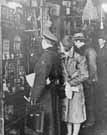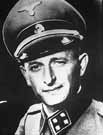
|
|
|

|

|

|

|
|
Click on an image to see a larger, more detailed picture.
|
|
|
|
|
| 1938: The End of Illusions |

|
pg. 129 |

|
|
|
|
| |
 Prospective buyers view confiscated property of German Jews before it appears on the auction block. Early in 1938 Hermann Göring, the plenipotentiary for the Four-Year Plan, initiated plans for systematically expropriating Jewish wealth. Jews were required to submit a comprehensive list of their domestic and foreign property; the property then was seized.
Prospective buyers view confiscated property of German Jews before it appears on the auction block. Early in 1938 Hermann Göring, the plenipotentiary for the Four-Year Plan, initiated plans for systematically expropriating Jewish wealth. Jews were required to submit a comprehensive list of their domestic and foreign property; the property then was seized.
Photo: YIVO Institute for Jewish Research/United States Holocaust Memorial Museum Photo Archive
|
 Prisoners of the Flossenbürg concentration camp in Germany endure hard labor while working in this stone quarry. Opened in May 1938 near the Bavarian town of the same name, the Flossenbürg camp was relatively small. Approximately 65,000 inmates were incarcerated before it was liberated on April 23, 1945, by U.S. troops. About 14,000 prisoners were reported to have died or were executed during the last 14 months of the war. Among the fatalities was German Pastor Dietrich Bonhoeffer.
Prisoners of the Flossenbürg concentration camp in Germany endure hard labor while working in this stone quarry. Opened in May 1938 near the Bavarian town of the same name, the Flossenbürg camp was relatively small. Approximately 65,000 inmates were incarcerated before it was liberated on April 23, 1945, by U.S. troops. About 14,000 prisoners were reported to have died or were executed during the last 14 months of the war. Among the fatalities was German Pastor Dietrich Bonhoeffer.
Photo: United States Holocaust Memorial Museum Photo Archive
|
 Adolf Eichmann
Adolf Eichmann
As the "Jewish specialist" of the SS, Adolf Eichmann zealously and efficiently organized the arrests and transportation of millions of Jews to death and concentration camps. Convinced of the importance and "necessity" of his task, he asserted that he performed his job "with all the fanaticism that an old Nazi would expect of himself." He found his work "fascinating" and admitted that doing it well gave him "uncommon joy." Eichmann joined the SS in 1932, and in 1934 he took a position in Reinhard Heydrich's Security Service (SD). Within the SD's Jewish Department, he became the leading expert on Jewish affairs. Disguised as a journalist, he traveled to Palestine in 1937 to study the possibility of deporting Jews to that region, but he concluded that the creation of a Jewish state "should be impeded." After the annexation of Austria in March 1938, he headed the Office of Jewish Emigration, acquiring expertise in "forced emigration" techniques: systematic physical violence, blackmail, and concentration-camp threats. At the 1942 Wannsee Conference, Eichmann received the task of implementing the "Final Solution." With utmost bureaucratic efficiency, he organized the technical aspects of the extermination policy--from roundups and train convoys to devising gassing procedures and setting death quotas in extermination camps.
|
|

|

|

|

|
 May 28, 1938: Jewish businesses in Frankfurt, Germany, are boycotted.
May 28, 1938: Jewish businesses in Frankfurt, Germany, are boycotted.
|
 May 29, 1938: Hungary restricts the proportion of Jews holding jobs in commerce, industry, the liberal professions, and the Hungarian government to 20 percent.
May 29, 1938: Hungary restricts the proportion of Jews holding jobs in commerce, industry, the liberal professions, and the Hungarian government to 20 percent.
|
 May 31, 1938: German legislation outlaws "decadent art."
May 31, 1938: German legislation outlaws "decadent art."
|
 June 9, 1938: The main synagogue at Munich is burned to the ground by Nazis.
June 9, 1938: The main synagogue at Munich is burned to the ground by Nazis.
|
 June 14, 1938: All Jewish businesses that have not already been registered and marked must now comply with the Reich requirement.
June 14, 1938: All Jewish businesses that have not already been registered and marked must now comply with the Reich requirement.
|
 June 15, 1938: Throughout Germany, any Jew "previously convicted" of a crime (even a traffic offense) is arrested.
June 15, 1938: Throughout Germany, any Jew "previously convicted" of a crime (even a traffic offense) is arrested.
|
|
|
|
|
| 1938: The End of Illusions |

|
pg. 129 |

|
|
The Holocaust Chronicle
© 2009 Publications International, Ltd.
|
|
